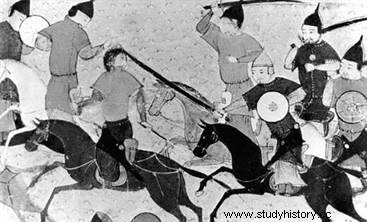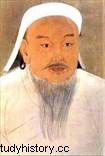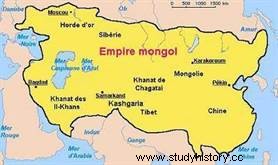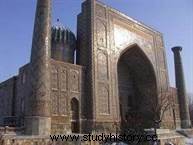 The Mongols were one of the most destructive conquering powers the world has ever known. In the 13th century, they emerged from the steppes of Asia, terrorizing the peoples established in Eurasia, from China to Hungary. And yet, less than a century later, the immense Mongol Empire had begun to disintegrate into several independent states. By the end of the 15th century, it had almost disappeared from history, leaving behind it, after an incredible ride, only ruins and desolation.
The Mongols were one of the most destructive conquering powers the world has ever known. In the 13th century, they emerged from the steppes of Asia, terrorizing the peoples established in Eurasia, from China to Hungary. And yet, less than a century later, the immense Mongol Empire had begun to disintegrate into several independent states. By the end of the 15th century, it had almost disappeared from history, leaving behind it, after an incredible ride, only ruins and desolation.
Ride in the steppes
The steppes, of vast plains similar to the prairies of North America, extending over 5000 kilometers from the Danube Plain in Eastern Europe to Manchuria in the East, through Southern Russia and Central Asia . The climate is harsh, marked by intensely cold winters and hot summers. The steppes were inhabited by tribes of nomadic pastoralists who moved their herds of horses and sheep over great distances in search of rich pastures, and traded with the sedentary peoples established near their borders.
 History has regularly seen bands of warriors rising from the steppes to attack the peoples living on the frontier, such the Huns of Attila , who terrorized Europe in the fifth century AD. These bands caused general panic and sowed desolation on their way, but their territorial conquests were ephemeral. This phenomenon was due to the fact that the nomadic tribes of the steppes did not have political and administrative structures capable of perpetuating their empires. Moreover, their leaders retained their authority only as long as they brought back spoils to reward their armies.
History has regularly seen bands of warriors rising from the steppes to attack the peoples living on the frontier, such the Huns of Attila , who terrorized Europe in the fifth century AD. These bands caused general panic and sowed desolation on their way, but their territorial conquests were ephemeral. This phenomenon was due to the fact that the nomadic tribes of the steppes did not have political and administrative structures capable of perpetuating their empires. Moreover, their leaders retained their authority only as long as they brought back spoils to reward their armies.
The Mongolian countryside
The most outstanding steppe warrior of all time was Temudjin, better known as Genghis Khan . It was in 1206 that this clan chief was proclaimed khan after having succeeded in unifying all the Mongol tribes under his command, and took his name which means "universal chief". An outstanding military leader, Genghis created what was probably the most brilliant army of horsemen that ever existed, which he led relentlessly through Central Asia, from northern China to Asia and Iran, then making it circumnavigate the Black Sea to reach the Caspian Sea and southern Russia. He thus conquered a territorial empire surpassing that of Alexander the Great.
 When Genghis Khan died, Ogoday (1229-1241), then Genghis Khan's grandson, Kublai ( 1260-1294) succeeded him. Their armies took control of Tibet, Korea, Persia, Iraq and much of Russia and Hungary. In 1279, after more than a decade of conquests of Song China, Kubilai khan takes the dynastic name of Yuan. This was the last great Mongol conquest. His campaigns in Southeast Asia did not bring lasting success, his attempts to invade Japan failing twice.
When Genghis Khan died, Ogoday (1229-1241), then Genghis Khan's grandson, Kublai ( 1260-1294) succeeded him. Their armies took control of Tibet, Korea, Persia, Iraq and much of Russia and Hungary. In 1279, after more than a decade of conquests of Song China, Kubilai khan takes the dynastic name of Yuan. This was the last great Mongol conquest. His campaigns in Southeast Asia did not bring lasting success, his attempts to invade Japan failing twice.
The Mongol army committed atrocities during their wars of conquest:more than 200,000 prisoners were massacred during the capture of Baghdad, between 1251. Their tactics of terror cost millions of human lives and inflicted lasting damage on the two most advanced civilizations of the time , that of Islam and that of China. The ancient trading cities of Central Asia, devastated, never regained their former prosperity. Vast areas of northern China, Persia and Iraq were depopulated, and Russia was relegated to the mainstream of European cultural development for nearly two centuries.
The Mongol domination, however, resulted in increasing commercial and cultural contacts between China and the rest of the world. The Mongols were less hostile to European Christians than the Muslims who had in the past controlled the trade routes through Central Asia. This allowed European merchants, such as Marco Polo, to travel to the Orient for the first time and bring back Chinese knowledge and technologies.
Dismemberment of the Mongol Empire
In 1235, the capital of the Mongol Empire was established at Karakorum , which had been Genghis Khan's favorite camp in Mongolia. But the immense Mongol territories proved too large to be governed effectively from one place, so subordinate khanates were created to administer the Western conquests:the Golden Horde Khanate in Russia (thus named apparently because of the color of the tent of the first khan) the Ilkhnat of Persia, the khanate of Jaghataï in the central steppes. Their leaders were supposed to come under the authority of the great khan, but they had all withdrawn from his direct authority when Kublai became khan in 1260.
 The Mongols had no prominent leader after Kublai, and their power began to decline, the khanates bursting into clans and rival states from the end of the twelfth century. The Mongols of the Golden Horde converted to Islam, alienating their Christian Russian subjects. In the east, Tibet regained its independence in 1294. China was liberated between 1356 and 1368 by a rebel leader, Zhu Yuanzhang. After taking Beijing, capital of the great khanate since 1266, the latter proclaimed himself the first emperor of the Ming dynasty (1366-1644). The power of the great khanate was then limited to the heart of the eastern steppes, Mongolia. It was over for the Mongols' dream of world conquest.
The Mongols had no prominent leader after Kublai, and their power began to decline, the khanates bursting into clans and rival states from the end of the twelfth century. The Mongols of the Golden Horde converted to Islam, alienating their Christian Russian subjects. In the east, Tibet regained its independence in 1294. China was liberated between 1356 and 1368 by a rebel leader, Zhu Yuanzhang. After taking Beijing, capital of the great khanate since 1266, the latter proclaimed himself the first emperor of the Ming dynasty (1366-1644). The power of the great khanate was then limited to the heart of the eastern steppes, Mongolia. It was over for the Mongols' dream of world conquest.
The campaigns of Tamerlane
Tamerlane (1361-1405), emir of Samarkand in the khanate of Jagatai, was the last of the Mongol conquerors. Although being a Muslim and of Turkish parents, he claimed to be the descendant of Chinggis khan; nomadic, he spent most of his life campaigning in Central Asia and the Middle East in an attempt to reconstitute the empire of the great khan.
Craftsmen he enslaved were taken to Samarkand to cover the city with mosques, which are among the most lavish in the Muslim world, but according to folklore he made build their towers with the skulls of his victims. Tamerlane's empire, like that of his predecessors, died with him. His campaigns left the Muslim world in ruins and dealt a fatal blow to the western khanates.
Bibliography
- From Jean-Paul Roux, History of the Mongol Empire. Editions Fayard, 1993.
- By René Grousset, The Empire of the Steppes:Attila, Genghis-Khan, Tamerlane. Payot, 2001.
- De Dominique Farale, From Genghis Khan to Qublai Khan:The Great Mongolian Ride. Economica, 2005.

